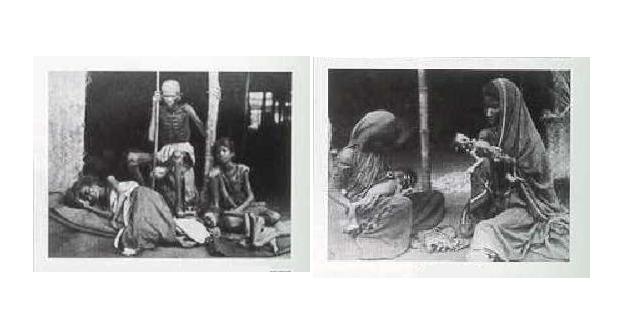Famine
W.W. Hooper, photographer, shot the famine extensively, some images had titles like "Famine Objects" showing a group of starved people, seated together in the centre of the frame.
[1]
Lord Canning had started the project to extensively document the Indian race. Hooper had come to India having joined the 7th Madras Cavalry.He stayed on 40 more years. His amateur interest in photography was noticed, appreciated. Lord Canning had set himself a project to collect and document photographs of India. Gradually, he made this into an official project under the India Office. The project proposed to document in order to control better. In 1862, Hooper was relieved from military duties. The horseman took to the camera. Subjects of the Central provinces were placed against a black cloth and Hooper dived under another black cloth to make their image as they stared ahead, into camera. Many of these photographs found place in the massive eight volume "The People of India: A series of photographic illustrations, with Descriptive Letter Press, of the Races and Tribes of Hindustan"
He went on to found a private firm where he photographed Anglo Indian life.
He was caricatured in Punch after he photographed the famine victims- it was alleged that he did not offer any help to the subjects he photographed, that he had ordered to be brought into the camps.
details in Encyclopaedia of Nineteenth Century Photographers [2] page 713
A horseman took to a camera/ He came to a country unknown/ He gathered up slices and froze them/ And planned to take them home.
But when he sat down to breakfast/ With the photos upon his plate/ The newspaper leaped up and caught him/ In a noxious debate
He is eating his subjects!! They yelled out/ The Englishman lost his head/ He lifted the shutter and climbed in/ And ate the horse instead.
Lytton is sometimes called the Nero of India for his callous attitude during the famine and for his spending crores on the Darbar.
excerpt from a contemporary account of Famine by a British writer http://www.payer.de/quellenkunde/quellen057.htm 1876 S.W. monsoon rains were deficient all over the Madras Presidency and in the Poona district, and the N.E. rains utterly failed. The drought in Bombay extended to nine districts in the Dekhan and Southern Mahratta country, including, Nasik, Ahmadnaggur, Poona, Sholapur, Satara, Kaladgi, Belgaum, and Dharwar ; and adjoining native states, Kolhapur, Phultun, Akulkote, and Sawuntwari, also suffered. The area of this territory, exclusive of native states, comprises about 54,000 square miles, and the total population amounts to eight millions, of which five millions were included in the tracts immediately affected. By October 1876 all the nine of the Bombay Dekhan districts were threatened with famine, as nearly all the monsoon crops had perished, and the spring and summer rains failed, and rain fell short all over India ; there were scarce rains also in Egypt, Morocco, and Brazil. In Madras famine affected the districts of Cuddapah, Bellary, Nellore, Kurnool, Madura, North Arcot, Salem, Chingleput, Coimbatore, Kistna, Trichinopoly, and Tanjore. In Mysore, and also some part of the Nizam's country, the area of the distressed districts amounted approximately to 80,000 square miles, and the total population afflicted to nearly 18 millions.
In the beginning of 1878, a trial census was taken of the districts of N. Arcot, Bellary, Chingleput, Coimbatore, Cuddapah, Kistna, Kurnool, Madras town, Madura, Nellore, and Salem. In these, in 1875-76, the deaths were 840,545 ; but in 1876-77 they increased to 925,103, or 67 per thousand of the population of 13,765,165. According to the estimated population at the end of 1876, the losses were in Bellary 21 per cent. ; Kurnool, 27 per cent. ; Cuddapah, 26 per cent. ; Nellore, 21 per cent ; Coimbatore, 17 per cent. ; Chingleput, 10 per cent. The Salem district estimated population in 1876 was 2,129,850. The actual population on the 14th of March 1878 was 1,559,876, that is, there were 569,956 souls in this one district, or nearly 27 per cent of the people, unaccounted for. And in this Salem district the famine distress was not then over.
In Mysore the January census showed that about 25 per cent., or one-fourth, of the population had melted away, equal to 1,250,000 souls.
In Bombay the average deaths had been 82,909 ; but in the year 1876-77 the mortality was 149,053, and there were 32,054 diminished births.
In Oudh, the N.W. Provinces, the Panjab, and Central Provinces, the deaths were abnormally great.
Great efforts were made to relieve the famine-stricken. The people of Great Britain subscribed about £800,000 ; the Government of India laid out about £10,000,000; and private individuals and the public servants in India vied with each other in efforts to save life. --- The immediate effects of famine soon disappear. An Indian population grows normally at the rate of 1½ per cent, per annum, and this proportion is within the mark in ordinary times. And within two years of the great famine of 1877-78 its injuries were no longer apparent, while calamities of other kinds continue to be remembered for long periods.
Army Sanitary Comm. Rep.; As. Soc. Journ.; As. Res.; Hunter's Rural Life in Bengal; Famine Comm. Rep.; India Administration Rep., vol. xii.; Proceedings of the Government of India; Saturday Review, 1878 ; Sanitary Commissioner of Madras, Report; Dr. W. W. Hunter in Geog. Magazine; Montgomery Martin's Famine Chronology, 1640 to 1841; Statistical Journal, 1843, i. 3d series, p. 468; Macmillan's Magazine; Geog. Mag., May 1877 ; Khafi Khan; Elphin. p. 510 ; Ward's Hindoos, iii. p. 107. See Food."
[Quelle: Balfour, Edward <1813-1889>: Cyclopædia of India and of eastern and southern Asia, commercial, industrial and scientific: products of the mineral, vegetable and animal kingdoms, useful arts and manufactures / ed. by Edward Balfour. -- 3rd ed. -- London: Quaritch. -- Vol. 1. -- 1885. -- S. 1072 - 1076.]
